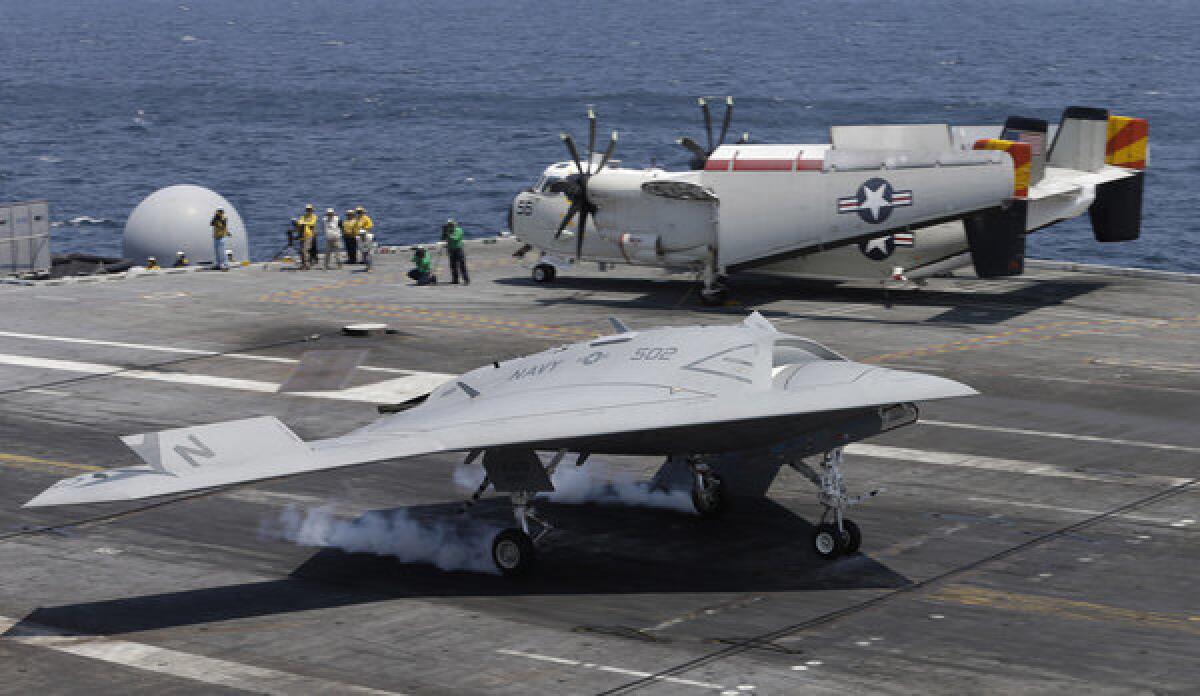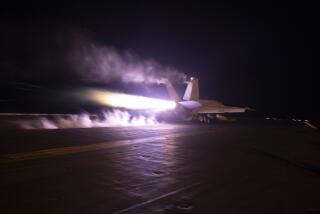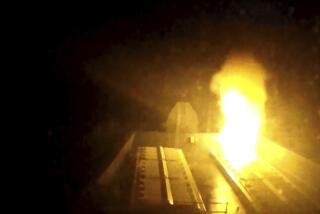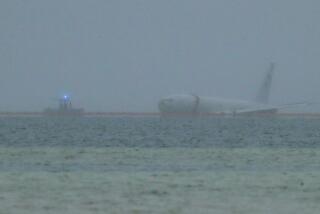Navy drone X-47B lands on carrier deck in historic first

The U.S. Navy conducted a historic flight test Wednesday off the coast of Virginia when an experimental bat-winged drone made an arrested landing aboard an aircraft carrier for the first time.
The flight of the drone, dubbed X-47B, could redefine naval aviation.
Landing on an aircraft carrier as it plies the ocean and pitches with the waves is considered an extremely difficult feat for even the most seasoned pilot. The X-47B was controlled almost entirely by computer.
âBy evolving and integrating new technology like the X-47B and the unmanned aircraft to follow, carriers will remain relevant throughout their 50-year lifespan,â Secretary of the Navy Ray Mabus said in a statement.
The X-47B, built by Northrop Grumman Corp., was launched from the deck Wednesday morning. The drone safely flew above the Atlantic Ocean came in for a landing on aircraft carrier George H.W. Bush off the coast of Virginia.
Relying on pinpoint GPS coordinates and advanced avionics, the sleek drone digitally communicated with the carrierâs computers to determine speed, crosswinds and other data as it approaches from miles away.
Then shortly before 1:45 p.m. Eastern time it hit the flight deck and hooked the arresting wire for a safe landing.
[Updated, 11:45 a.m. PDT July 10: The Navy announced that 45 minutes after the first landing, the drone completed a second successful landing on the carrier.]
The test was seen as a milestone in drone technology and the program, which has been eight years in the making.
Currently, combat drones are controlled remotely by a human pilot. But the X-47B is designed to carry out a combat mission controlled almost entirely by a computer. A human pilot would design its flight path and send it on its way; a computer program would guide it from a ship to the target and back.
What also sets this drone apart from most of todayâs combat drones is that it is stealthy and jet-powered.
The X-47B, which resembles a miniature B-2 stealth bomber, has a 62-foot wingspan and can fly higher than 40,000 feet. It has a range of more than 2,400 miles and can reach high subsonic speeds. The Navy has nicknamed it âSalty Dog 502.â
The drone is designed to fly farther and stay in the air longer than existing aircraft because it does not depend on a human pilotâs endurance. Navy fighter pilots may fly missions that last as long as 10 hours. Current drones can fly for three times that long.
The X-47B is an experimental jet -- thatâs what the X stands for -- and is designed to demonstrate new technology, such as automated takeoffs, landings and refueling. The drone also has a weapons bay with a payload capacity of 4,500 pounds, but the Navy said it has no plans to arm the aircraft.
The first X-47B had its maiden flight from Edwards Air Force Base in 2011, where it continued testing until last year when it was trucked from the Mojave Desert to Naval Air Station Patuxent River in Maryland.
The droneâs design was so startling that motorists passing it by on the highway thought it was a UFO.
Over the last year, the Navy conducted shore-based catapults at Patuxent. It also conducted deck-handling and ship-integration testing to demonstrate the capability to safely operate the X-47B on an aircraft carrier flight deck.
In May the drone had its first carrier-catapulted flight.
There were two X-47Bs developed and built under a contract that has escalated to $1.4 billion. Both were constructed behind barbed-wire fences and double security doors at Northropâs expansive facility in Palmdale.
Much of the droneâs design work was completed at the companyâs facilities in El Segundo and Rancho Bernardo.
ALSO:
Problem-plagued missile defense system fails in $214-million test
SpaceX uses drone to capture footage of hovering Grasshopper rocket
Navy awards contract for next generation of electronic attack jammers
More to Read
Inside the business of entertainment
The Wide Shot brings you news, analysis and insights on everything from streaming wars to production â and what it all means for the future.
You may occasionally receive promotional content from the Los Angeles Times.











